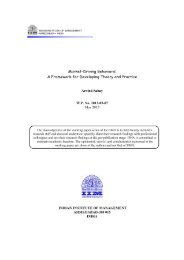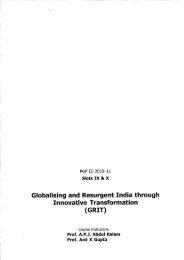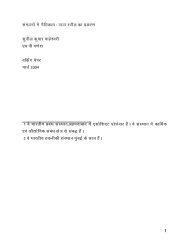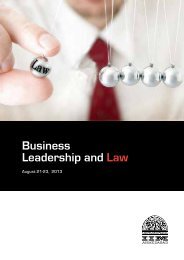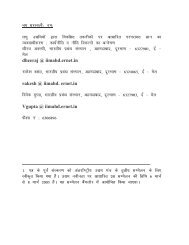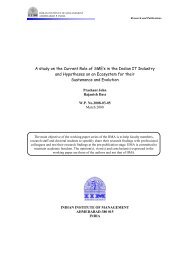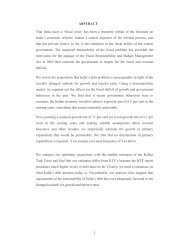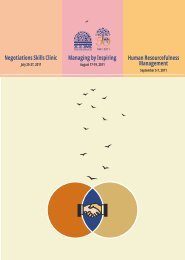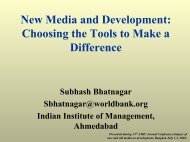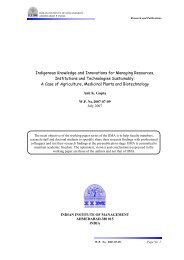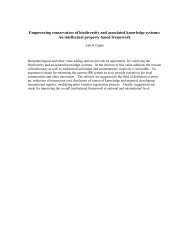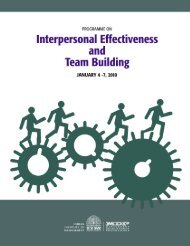related paper - Indian Institute of Management, Ahmedabad
related paper - Indian Institute of Management, Ahmedabad
related paper - Indian Institute of Management, Ahmedabad
Create successful ePaper yourself
Turn your PDF publications into a flip-book with our unique Google optimized e-Paper software.
VIJAYA SHERRY CHAND<br />
21<br />
Here we specifically use the theoretical model linking<br />
innovation, knowledge and networks, developed by<br />
Swan et al. (2003), to examine how the EI Bank can<br />
be adopted and implemented by educational administrators<br />
working at a regional or national level. Swan<br />
et al. conceptualize innovation as a set <strong>of</strong> “episodic”<br />
processes, which cover the three stages <strong>of</strong> design<br />
and development or the “invention episode”, the<br />
spread or the “diffusion episode” and the adoption<br />
<strong>of</strong> new ideas by others, the “implementation episode”.<br />
These three episodes are not structured linearly<br />
or sequentially; rather, they are to be seen as iterative<br />
and recursive processes. The key insight that Swan<br />
et al. provide is that specific types <strong>of</strong> networks and<br />
network activities are required during particular<br />
episodes. Innovation, thus, is “reciprocally and systematically<br />
intertwined” with the creation and<br />
maintenance <strong>of</strong> networks. Such a processual view<br />
<strong>of</strong> networks sees innovation as flows and combinations<br />
<strong>of</strong> knowledge and information, which are open<br />
to reshaping. Networking involves “the active search<br />
and development <strong>of</strong> ideas, knowledge and information<br />
through the creation and articulation <strong>of</strong> informal<br />
relationships within a context <strong>of</strong> more formal intraand<br />
inter-organizational structural arrangements”<br />
(ibid.: 681). Thus, networking processes can span<br />
different structures (hierarchies as well as more<br />
loosely-structured units). In summary, roles <strong>of</strong> networks<br />
vary across episodes; knowledge transformation<br />
(construction, communication and exchange) is<br />
one <strong>of</strong> the roles <strong>of</strong> such networks; the processual dimensions<br />
<strong>of</strong> networks should not be ignored; personal<br />
sense-making and trust-building change as networks<br />
evolve; and different kinds <strong>of</strong> knowledge have<br />
different implications for the specific roles <strong>of</strong> networks.<br />
From more local and intra-organizational networking<br />
during the invention episode, the focus shifts to<br />
wider networks for knowledge objectification in the<br />
diffusion episode and then returns to more local<br />
networks in new contexts so that knowledge appropriation<br />
or implementation becomes possible in these<br />
new contexts. During the invention episode, social<br />
construction <strong>of</strong> knowledge, free and extensive exchange<br />
<strong>of</strong> ideas interpersonally, and loose interpersonal<br />
structures which crystallize ideas, are important.<br />
Rogers (1995) also stresses the importance <strong>of</strong><br />
the “communicated experience” <strong>of</strong> the immediate<br />
peer circle; the implication is that teachers who are<br />
networked in an invention episode will have more<br />
faith in their partners who have generated the idea.<br />
In the EI Bank initiative, the early stages <strong>of</strong> teacher<br />
identification and networking, subjecting innovations<br />
to peer scrutiny and the screening procedures used,<br />
served the purpose <strong>of</strong> the social construction <strong>of</strong><br />
‘solution knowledge’. The conferences and fellowships<br />
that were built into the project also helped in<br />
the creation <strong>of</strong> loose interpersonal structures—evidence<br />
is provided by some <strong>of</strong> the teachers using the<br />
fellowships they received to try out things their peers<br />
in the face-to-face network had evolved.<br />
In the diffusion episode, commoditization—making<br />
tacit knowledge explicit—is more important.<br />
Diffusion ceases to be dependent on the tacit knowledge<br />
<strong>of</strong> its creators. The network’s role is thus legitimation<br />
and communication <strong>of</strong> objectified and<br />
“commodified” knowledge using best practice<br />
methodologies. Networks that communicate also<br />
validate or legitimate. Boundary spanning individuals<br />
or “honest brokers” play an important role at this<br />
stage, and there is a reliance on surrogate indices <strong>of</strong><br />
the validity <strong>of</strong> the knowledge being diffused. This<br />
is the rationale for processing the practices into<br />
printed cases, yearbooks <strong>of</strong> innovations, and a<br />
searchable database, so that other stakeholders can<br />
access such knowledge through “user-friendly”<br />
formats. The prior informed consents <strong>of</strong> the teachers<br />
and the role <strong>of</strong> outside experts in validation also<br />
served to legitimize the knowledge that was converted<br />
into products. Such “network communications”<br />
screen the identified innovations on the basis <strong>of</strong><br />
merit and “actors <strong>of</strong> poor character and judgment,<br />
as well as poorly conceived ideas, are quickly identified<br />
and discredited” (Mintrom and Vergari 1998:<br />
128).<br />
The implementation episode deals with the appropriation<br />
<strong>of</strong> objectified ideas and adaptation <strong>of</strong> these<br />
to new local contexts in which the implementation<br />
happens—in other words, the objectified ideas need<br />
to be blended with the tacit knowledge that exists in<br />
the new contexts. The networking processes at this<br />
stage are purposeful and intentional, and the focus<br />
is on exchange <strong>of</strong> information and resources. The<br />
nature <strong>of</strong> knowledge transformation at this stage is<br />
best characterized as unpacking knowledge and recombining<br />
it with the local knowledge that exists in<br />
new contexts.<br />
This third episode needs to be visualized carefully<br />
since local knowledge evolved in contexts <strong>of</strong> socioeducational<br />
deprivation by the creator-teachers has<br />
to be “unpacked” and re-contextualized in new contexts,<br />
and blended with the tacit knowledge that userteachers<br />
in the new contexts possess. The network<br />
relevant to this episode includes a wider cross-section<br />
<strong>of</strong> stakeholders, including administrators who are<br />
hopefully sensitized to the value <strong>of</strong> an approach that<br />
‘builds on the strengths within’. Though the EI Bank<br />
has tried out a curriculum module and demonstration<br />
<strong>of</strong> model to educational administrators, as mechanisms<br />
to communicate this third episode, it may be<br />
more useful, during this episode, to stress the concept<br />
<strong>of</strong> “policy entrepreneurs”.<br />
Educational administrators usually visualize innovation<br />
in terms <strong>of</strong> the two broad strategies <strong>of</strong> educa-



